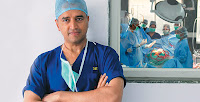 The typical American hospital charges between $20,000 and $100,000 to perform open-heart surgery. The 1,000-bed Narayana Hrudayalaya Hospital in Bangalore, India, charges $2,000 on average — and, arguably, provides better quality outcomes.
The typical American hospital charges between $20,000 and $100,000 to perform open-heart surgery. The 1,000-bed Narayana Hrudayalaya Hospital in Bangalore, India, charges $2,000 on average — and, arguably, provides better quality outcomes.
The factory model of medical care, in which hospitals, physicians, nurses and other staff focus with unremitting attention to efficiency and quality on a narrow scope of services, is so successful that entrepreneur/heart surgeon Devi Shetty is raising $90 million in private capital to build four more “health cities” in India. He also has plans to build a 2,000-bed general hospital in Grand Cayman, an hour’s plane ride from Miami, were he plans to price medical procedures at 50% less than what they cost in the United States.
The story of Devi Shetty, recounted today in the Wall Street Journal, demonstrates in the most vivid possible way the extraordinary cost savings that could be achievable if the U.S. had a market-based health care system that focused on productivity and quality as opposed to the highly government regulated system where the emphasis is on shifting costs.
Narayana Hrudayalaya is not for wealthy Indians only. The story also shows how higher productivity translates into lower costs and greater access for the poor. One third of the hospital’s patients are poor farmers covered by an insurance plan, crafted in partnership with the state of Karnataka, costing $3 per year per person and reimbursing the hospital $1,200 for a surgery, slightly less than the hospital’s $1,500 break even.
How does Shetty do it? By paying Third World wages to his hospital staff? No, cardiac surgeons are paid between $110,000 and $240,000 annually — less than in America, perhaps, but not exactly coolie wages.
By cutting corners on quality? Well, no. Quality comparisons are difficult to make but they tend to favor Narayana Hrudayalaya. As the Journal writes: “Narayana Hrudayalara reports a 1.4% mortality rate within 30 days of coronary bypass graft surgery, one of the most common procedures, compared with an average of 1.9% in the U.S. in 2008, according to data gathered by the Chicago-based Society of Thoracic Surgeons. What those data don’t do is adjust for the morbidity of the patients treated. Because so many of the Indian patients lack access to basic health care and suffer from more advanced cardiac disease, Narayana Hrudayalaya probably treats sicker patients, making the quality disparity even more pronounced.
Shetty delivers superior productivity and outcomes by adopting a manufacturing model of process efficiency and quality control. “Japanese companies reinvented the process of making cars. That’s what we’re doing in health care,” Shetty says. “What health care needs is process innovation, not product innovation.”
Needless to say, the health care atrocity lumbering through Congress pays zero attention to process innovation. Indeed, by encumbering the health care system with more bureaucracy and more rules, health care “deform” would most likely hinder process innovation.
There’s a revolution in medical care occurring in the world, and India is at the epicenter. But it’s not the only player. The phenomenon of medical tourism is growing by leaps and bounds. The Journal quotes consulting firm Deloitte as saying that six million Americans are expected to travel to other countries next year in search of more affordable medical care, up from 750,000 who did so in 2007. In the absence of market-based reform of the health care system, we will see those numbers grow as Shetty builds his hospital in Grand Cayman and other entrepreneurs build similar facilities in locales from Central America to the Caribbean.
Thus, the braniacs in Congress, in their monumental conceit that they know better than the health care professionals how to run a health care system, will not only increase the cost of health care and accelerate the country’s rush to bankruptcy, they will succeed in hollowing out our world-class medical industry.
The question we should be asking ourselves is this: Why isn’t Shetty building his 2,000-bed hospital in the United States instead of Grand Cayman? What laws, regulations and incentives obstruct the operation of a heart hospital that would save patients millions of dollars and improve the quality of their care? For what reason, and to what ends, are we depriving Americans of superior, lower cost health care by means of process reform?


